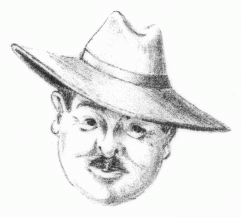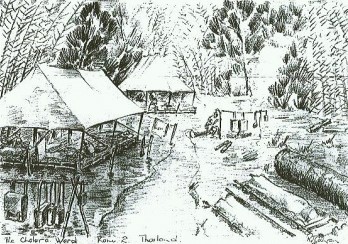 |
 |
![]()
| Major Alan Richard Hazelton - NX 35134 |
| Medical Officer 2/10 Field Ambulance-later “D” Force Thailand |
 |
| Drawn by Lt Fred "Smudger" Smith (Ransome Smith) around 1943, vicinity of Kanchanaburi |
Major Alan Hazelton was born in Artarmon NSW in 1915. He studied medicine at Sydney University. Following graduation, he worked at Royal Price Alfred Hospital and Orange Base Hospital. Around this time, he joined the militia in the 2/10 Field Ambulance (along with a number of other Medical Officers who also became POWs). He enlisted in the AIF in July 1940 and moved to Singapore around October 1941 as a member of 8th Division. During the Defence of Singapore Alan was stationed at St. Anthony’s Cathedral and at Tanglin. Along with more than 20,000 Australians he became a POW in Singapore on 15th February 1942.
In June 1942 the Japanese decided to build a railway to join the rail systems of Burma and Thailand. It was to be 421 Km long, single track and 1 metre guage. In March 1943 Alan was sent to Thailand as the Senior Medical Officer of “D” Force. This was a force of 5,000, which included 2,220 AIF. He had 5 other Australian Medical Officers and one Dental Officer with him. The Medical Officers were all from New South Wales and all graduated around the same time from Sydney University. Alan’s Medical colleagues were Captains Dick Parker, Reg Wright, Phil Millard, David Hinder and Ian Duncan. The Dental Officer was Captain Jim Finimore from Queensland. Alan advises that Finimore had a treadle dental drilling machine. Finimore also made a mixture of zinc oxide and eugenol (oil of cloves) for use for temporary fillings. When Major Hazelton was in Singapore he acquired as many medical supplies as he could and when he went to Thailand he took the medical supplies together with his microscope.
Whilst in Thailand he was located at Tarsao, Konyu, and Nakhon Pathom. On arrival at Tarsao he handed all his medical supplies over to the senior Medical Officer Lt Col Bill Harvey. He also set up his microscope in an atap hut. He had to rely on natural light to operate the scope. When he examined the first slide of an Amoebic Dysentry patient he was amazed at what he saw. The slide was covered with parasites charging all over the slide like two football teams. It was also at Tarsao that he took an interest in the POWs who were suffering with psychiatric problems. Nothing had previously been done for these unfortunates. Some of the British Medical Officers he worked with were Lt Col Bill Harvey, Captains Emil Lee and Vardy.
He was a great admirer of the work of a RAMC Medical Officer Canadian born Captain Jacob Markowitz, who he described as the most interesting person he ever met. Captain Markowitz performed 1,180 major operations and 3,800 transfusions on the line (an article on Markowitz will appear in due course). He also had contact with Captain Stanley Pavillard of Straits Settlements Volunteer Forces.
After some time at Tarsao he was sent by the Japs to sort out a problem at the Konyu Hospital Camp. On arrival he found around 800 sick. Many of the sick had been lying on the bed slats for up to six weeks. They seemed thoroughly depressed. He told an NCO to get all who could stand “on parade”. They were a dirty scruffy lot. He told them to right turn and march down to the creek and wash themselves. This accomplished, he told them to get water and go into the huts and wash the men who could not get to the creek.
Alan admits that while this was going on he was buying time as he thought through the options open to him. He only had a butter box of medical supplies with him. Within days the moral in the camp started to improve. There was a dying/ cholera hut at the back of the camp
(See drawing below by Dick Cockran).

Cholera Hut Konyu 2
There were about 10 deaths a day. During his time at Konyu he had cause to visit a nearby camp. It was a real slog to move between the two camps and Alan was at times knee deep in mud. On arrival at the other camp he found Major Ernie Marsden there. Ernie had been his senior at Prince Alfred Hospital in Sydney. Whilst overjoyed at seeing each other, they sat down on a log and cried. Things were so desperate!
Later at Nakhon Pathom, a Hospital Camp for up to 10,000 patients, he undertook eye surgery. Alan was not a specialist in this area of Medicine, but knowing there was a need for this service and, relying on his recall of ophthalmic procedures which he had observed when he was a resident doctor, undertook these procedures. It was around this time that he had contact with Lt Fred (Smudger) Ransome Smith, an officer of the Suffolks Regiment. Fred Ransome Smith, who was an artist pre-war, did a drawing of Alan whilst they were on the line. (Fred, a resident of Brighton Beach Victoria, recently passed the original of the drawing to Alan, having kept it for 60 years). Fred Ransome Smith, at Alan’s request, did water colour representations of eye conditions. These were retained by Alan Hazelton for many years and have been passed, together with other items including medical instruments, to the Australian War Memorial. The items at the AWN can be viewed on www.awm.gov.au/database/collection.asp and using the search function type in “Hazelton”. Alan himself constructed an ophthalmoscope (used a mirror for illumination), an optical bench and various eye instruments, which he later used at Nakhon Pathom. These are displayed at the War Museum at Goulburn.
In 1944 Alan moved from Tarsao to Nakhon Pathom (a hospital camp designed for 10,000 patients, but, never had more than 8,000), where he served under Lt Col Albert Coates. He also carried out experiments on sick patients to test the effect of giving them eggs to improve their condition and prepared a written report on his findings. He also did eye operations.
Alan comments that Captain (Professor) Markowitz stimulated the medical officers to do most interesting work. Markowitz gave lectures to the Medical Officers. In fact, on one occasion the Japs thought that Markowitz’s diagrams on a board were escape plans. Markowitz developed a method of defibrillating blood to facilitate blood transfusions. He regarded Markowitz as the outstanding Medical Officer he had contact with.
It was also at Nakhon Pathom that Alan did over 40 post mortems. He hoped to bring home evidence of the conditions that men died from. He salvaged pituitaries and stored them in spirit. When the Japs discovered what was being done, they banned autopsies and destroyed the specimens.
During 1943 Alan had the opportunity to send a 25-word message home. He decided to try to get a special message out using cryptic wordings. These are the particular words he used. “My best regards to Carl’s, Elizabeth Street and Ebi Hallam’s”. His wife realised that there was a message in the words, but, could not figure it out. She consulted a number of people without success. Some thought he was off his “rocker”. The thrust of the message was-
- “Carls” was a restaurant, which Alan and his wife went to in Sydney.
- “Ebi “ was a reference to Emetine Bismuth Iodine and
- “Hallams” was a reference to Hallams Pharmacy in Philips Street, Sydney.
His wife referred the message to her friend who was a pharmacist at Hallams, who took the message to a pharmaceutical meeting. Someone said that Alan was asking for Emetine Bismuth Iodine to treat dysentery. His wife approached the Australia Red Cross, who referred it to the International Red Cross, who in turn referred it to the Thai Red Cross. Some two years later Alan was summoned to the Jap Commander’s office at Nakhon Pathom and asked how he managed to get a message out to Australia. He pointed out that he had no communication other than the 25 word messages which were seen by the Japs. Then Alan was introduced to a Thai Red Cross officer, who presented him with 500 grams of Emetine Bismuth Iodine.
Alan remained in Thailand to the end of the War and was discharged from the Army on 16th February 1946. Alan resisted an invitation from Jacob Markowitz to further his medical career in the United States and established a Medical Practice in Goulburn and retired in 2001. His wife had died in 1995. He later left Goulburn and now (2005) resides in Canberra.
Notes prepared by Lt Col Peter Winstanley OAM RFD JP from telephone discussions with Alan and listening to a recorded interview by the late Lt Col ( Dr) Barbara Pocock.
E-mail peterwinstanley@bigpond.com website www.pows-of-japan.net
|
|